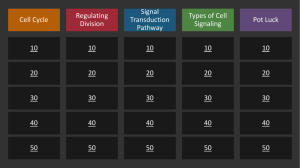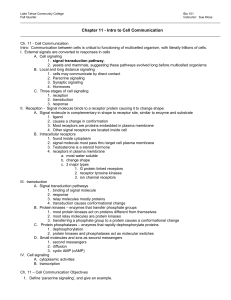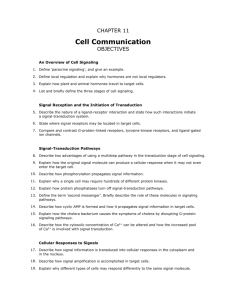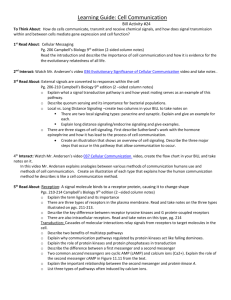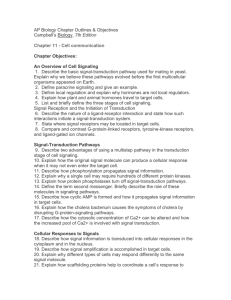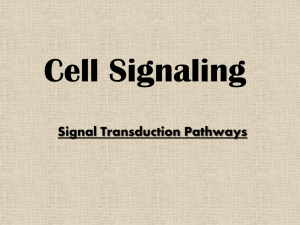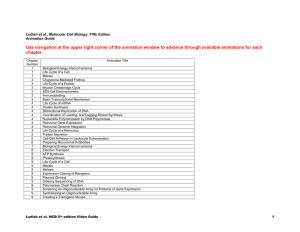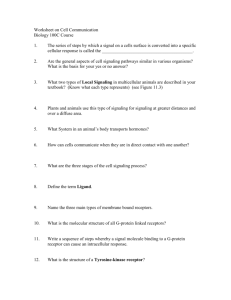Unit 3—Review Sheet Big Ideas 1, 2, 3, & 4 Cell Communication
advertisement
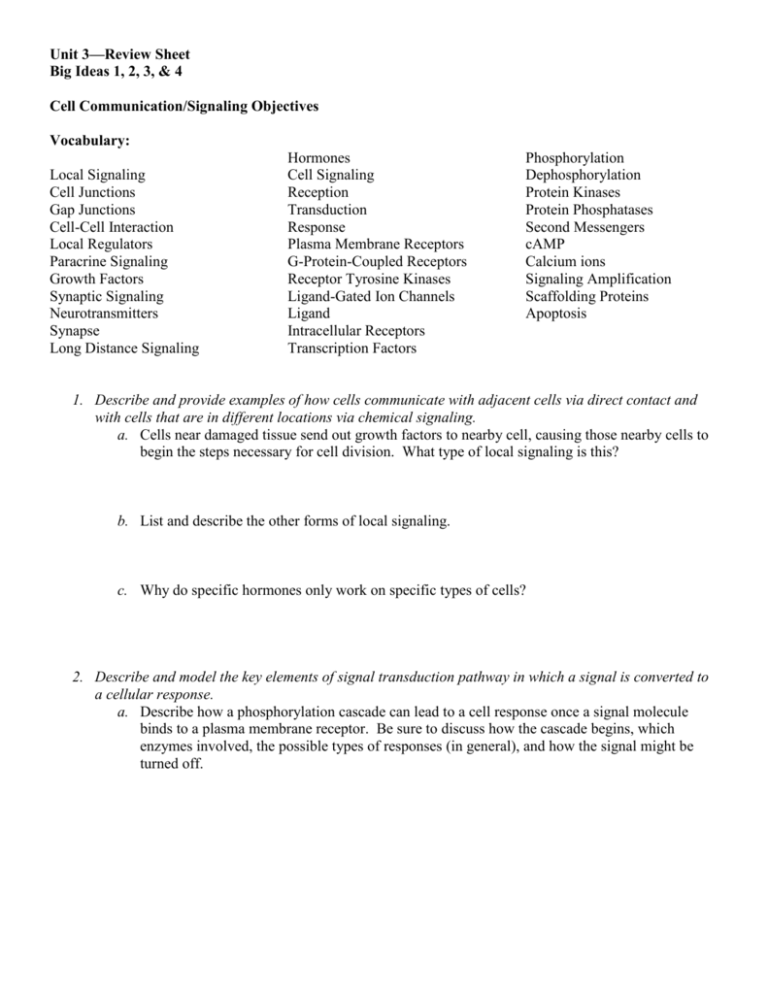
Unit 3—Review Sheet Big Ideas 1, 2, 3, & 4 Cell Communication/Signaling Objectives Vocabulary: Local Signaling Cell Junctions Gap Junctions Cell-Cell Interaction Local Regulators Paracrine Signaling Growth Factors Synaptic Signaling Neurotransmitters Synapse Long Distance Signaling Hormones Cell Signaling Reception Transduction Response Plasma Membrane Receptors G-Protein-Coupled Receptors Receptor Tyrosine Kinases Ligand-Gated Ion Channels Ligand Intracellular Receptors Transcription Factors Phosphorylation Dephosphorylation Protein Kinases Protein Phosphatases Second Messengers cAMP Calcium ions Signaling Amplification Scaffolding Proteins Apoptosis 1. Describe and provide examples of how cells communicate with adjacent cells via direct contact and with cells that are in different locations via chemical signaling. a. Cells near damaged tissue send out growth factors to nearby cell, causing those nearby cells to begin the steps necessary for cell division. What type of local signaling is this? b. List and describe the other forms of local signaling. c. Why do specific hormones only work on specific types of cells? 2. Describe and model the key elements of signal transduction pathway in which a signal is converted to a cellular response. a. Describe how a phosphorylation cascade can lead to a cell response once a signal molecule binds to a plasma membrane receptor. Be sure to discuss how the cascade begins, which enzymes involved, the possible types of responses (in general), and how the signal might be turned off. b. Compare and contrast plasma membrane receptors and intracellular receptors. c. What are two common second messengers? In general, how do each of these second messengers work? 3. Explain how changes in signal transduction pathways can alter cellular response. a. What might happen to a signal if a protein kinase in a signal transduction pathway is inhibited? b. What might happen to a signal transduction pathway if a gene mutation changes the structure of a phosphatase so that the enzyme can no longer remove phosphates from other proteins? 4. Compare and contrast eukaryotic cells and prokaryotic cells in terms of cell communication. Describe how these similarities and differences provide evidence for the evolutionary relationship between prokaryotic and eukaryotic cells. a. Explain quorum sensing. How does this feature of cell communication show a relationship between bacteria cells and multicellular organisms? Cell Cycle Objectives Vocabulary: Cell Cycle G1 G0 S G2 Mitosis Prophase Metaphase Anaphase Telophase Cytokinesis Cleavage Furrow Cell Plate Chromosome Chromatids Chromatin Centromere Diploid Haploid 1n, 2n, 4n Spindle Fibers Kinetochores Kinetochore Microtubules Non-kinetochore Microtubules Centrioles Centrosomes Checkpoints Cyclin-Dependent Kinase Maturation Promoting Factor Density-Dependent Inhibition Anchorage Dependence Cancer p53 Oncogenes Tumor Suppressor Genes Stability Genes Benign Malignant Metastasis Angiogenesis 5. Diagram, label, and describe the parts of the cell cycle. a. Label the following structures on the diagram to the right: Mitosis Interphase G1 G2 S Checkpoint 1 Checkpoint 2 Mark 4n and 2n in appropriate place Mark G0 Mark where p53 works 6. Outline the sequence of events in mitosis that allow for the even distribution of genetic material. a. What must happen in interphase to guarantee that each new daughter cell will be genetically identical once mitosis and cytokinesis occur? b. A diploid cell has 30 strands of DNA in G1. How many chromosomes and strands of DNA will the cell have in the following stages of the cell cycle? Stage Prophase Metaphase Anaphase # Chromosomes # DNA Strands 7. Describe components of cell cycle regulation. a. Describe what happens at checkpoints 1 and 2. How are the “checks” at these points of the cell cycle communicated within the cell? b. Which fluctuates in concentration cyclins or kinases involved in the cell cycle? c. What is the difference between density=dependent inhibition and anchorage dependence? 8. Define cancer and explain how aberrations in the cell cycle can lead to tumor formation. a. Explain 4 defining characteristics of cancer. b. Describe how oncogenes, tumor suppressor genes, and stability genes work in a normal cell versus a cancerous cell. c. Are gene mutations the only thing that cause cancer? Explain. d. What is met by a germ-line mutation versus a somatic mutation? 9. Compare and contrast eukaryotic cells and prokaryotic cells in terms of cell division. Describe how these similarities and differences provide evidence for the evolutionary relationship between prokaryotic and eukaryotic cells. a. How are mitosis and binary fission similar? How are they different? b. How do these similarities and differences account for their relationship?
